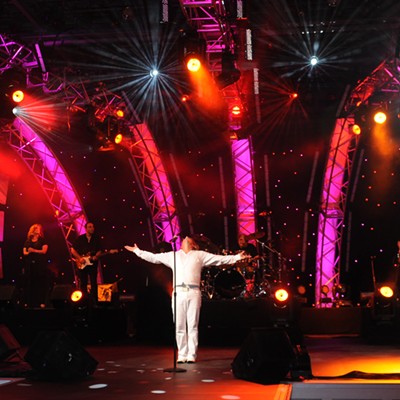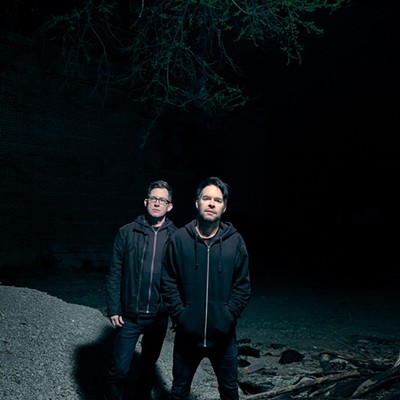Metal is inherently pretentious, and we don't care if outsiders get it or not. But we are witnessing a singularity, a critical mass, an Ouroboros of insular reference. Sunn O))) is merely the portentous harbinger. Full disclosure: I am a fan. While I believe that Sunn is a wonderfully progressive tangent off of the metal timeline, they are simultaneously a total in-joke punch line. Their hooded shrouds cover their faces so that we can't tell if they're winking at us. They are too self-aware—too meta-modern—to not see the fine line they are straddling. Is Sunn the Carlos Castaneda of metal—a project built upon the debate of it even being real with the creators' poker face giving nothing away?
Is that a bad thing? As if rising to the occasion, Sunn answered the challenge that no one made: how to make metal even more pretentious? By combining the genre's long-winded fantasies and concepts with the articulation and presentation of a MOMA installation, the band has both raised the music to new heights of art and tuned it way down to unplumbed lows of the preverbal, none of which would gel if it weren't actually good.
But how far is too far? This is a style in which the entire foundation is built on one-upping extremes: louder, heavier, faster, more brutal, more confrontational, communicating the limits of alienation until the music itself is wholly alien.
To put it another way, how many amps is too many? Where does it cease to accentuate the physical experience of sound and begin to showcase a bank account and the uncommon ability to not only purchase all of those amps, but also pay for their maintenance and transport? How many extra loads of coal have to be processed to keep the alternating current flowing, and is that so evil that it's fucking badass and therefore metal as hell? Is the answer something as deeply American as "because we can," or is there no answer because the question cannot escape the gravitational pull of the infinitely dense low-A bass chord?
More interestingly, what is the endgame here? Is there a moment in the future when metal, collectively, says, "actually, wait, yeah that's loud enough," or are we headed for Scanners-style head explosions and physically intolerable organ vaporization? Will Sunn O))) eventually be sub-contracted by Phelps-Dodge to assist in mountaintop removal?
Anyway, now we have Kannon, a new album from Sunn that sounds like no one else, complete with a scholarly press release citing collaborations with probably-famous Swedish designers and "critical theorists" that I'm too much of a mouth-breather to have ever heard of—to the point where I can't help but wonder if they write these one-sheets first, and then create the music as a kind of soundtrack. More importantly: is it good? Sure. I finally came to understand vocalist Atilla Csihar's growl-speak as the singing equivalent of what Sunn has been doing to guitar riffs this whole time: slowing and stretching the usual metal screams until it is pure texture, deeply microcosmic and genuinely creepy.
So, all humor aside, Sunn is actually more like the Kanye West of metal: using its genre as a home base to synthesize other disciplines and mediums previously thought way beyond black t-shirts and corpse paint. In doing so, they elevate what was once thought to be a lowly, plebeian sub-caste of music into new critical light alongside things that (I guess) are more respected in college—like the aforementioned critical theory. And, like Kanye, they aren't the first or necessarily the most extreme in this pursuit of gallery-metal (see: Liturgy), but they are hands-down the most relevant.
Yet, the alarmists must ask, is this diversification and outgrowth a good thing, expanding the bouquet, or does it dilute the metal ecosystem by introducing invasive species that will one day overshadow the roots?
To paraphrase the master of self-awareness himself, Phil Elverum, "being a fan of entropy, gardening brings me no joy.".







